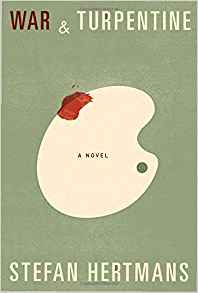 Stefan Hertmans, War and Turpentine: A Novel (New York: Pantheon, 2016), 290pp.
Stefan Hertmans, War and Turpentine: A Novel (New York: Pantheon, 2016), 290pp.
A few months before he died in 1981 at the age of ninety, First Sergeant-Major Urbain Joseph Emile Martien, an artist and decorated veteran who served on the front lines in World War I, gave his grandson Stefan Hertmans two notebooks. At the age of seventy-two, almost fifty years after the war, Urbain had started to record his experiences of the Great War. He wrote for seventeen years — six hundred pages of memories.
Hertmans, a prominent Flemish poet, novelist, and playwright, didn't look at those notebooks for thirty years. He says that he was "too scared." But as the 100th anniversary of the war approached, in 2011 he began to read the diaries as a way to honor his grandfather. He then turned those diaries into this novel of autobiographical fiction. The original Dutch version was published in 2013, translated into twenty languages, won many awards, and then published in English in 2016, and subsequently named on many book-of-the-year lists. The Guardian even called it a "future classic."
In Part I, the grandson narrates the early years and family history of his grandfather Urbain — a life of Dickensian poverty, begging for coal, and working in the foundry from the age of thirteen (which explained the strange purple indentations that the little boy remembers seeing on his grandfather's back). But there was always the beauty of art — Urbain's own father, Franciscus, was "a lowly church painter."
Part II makes for difficult reading, as well it should, for it's a first person account of Urbain's war experiences. The smell of charred flesh. Drinking water from canals filled with bloated corpses. Endless days in trenches filled with ice, mud, and rats. Waking up so cold that your wet uniform was frozen stiff as a board. And everywhere and always the panic, confusion, death, disease, and deserted villages. Urbain returned home and took early retirement at the age of forty-five as a disabled veteran, left to "wrestle with the demons deep inside."
Part III circles back to another deeply painful experience that formed Urbain's life. Not long after getting engaged to his beloved Maria Emelia, she died of the Spanish flu — the virus that killed 100 million people around the world just after the horrors of the war. And so Urbain married Maria's sister Gabrielle, who became his wife of forty years. These last decades were also times when Urbain returned to what he had always wanted to do, which was to paint like his father.
And so Urbain's lifelong battle "between the transcendent, which he yearned for, and the memory of death and destruction, which held him in its clutches." He was "tossed back and forth between the soldier he had to be and the artist he'd wished to become. War and turpentine."


